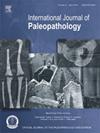A comparative approach to bony changes in maxillary and frontal sinuses as indicators of upper respiratory health
IF 1.5
3区 地球科学
Q3 PALEONTOLOGY
引用次数: 0
Abstract
Objective
The central aspect of this study is to provide a detailed comparison of bony changes in the maxillary and frontal sinuses in human skeletal remains in an effort to assist researchers record lesions and assist with potential diagnoses.
Materials
198 adult human remains from a medieval Avar population from Vienna, Austria.
Methods
Analysis of bony changes using an endoscopic multifunctional camera with an ultra-small lens and adjustable LED lights.
Results
Most common findings in both the maxillary and frontal sinuses are “pitting” and “white pitted bone”. However, significant differences between the maxillary and frontal sinuses regarding the frequency and variation of bony lesions exist.
Conclusion
The maxillary sinuses exhibited significantly greater prevalence of bony changes compared to the frontal sinuses but frontal sinuses, which generally are less frequently affected by inflammatory, malignant, or benign lesions, may ultimately provide more informative insights in paleopathological studies concerning the health of the upper airways than the maxillary sinuses.
Significance
Considering that most paleopathological studies on paranasal sinuses focus primarily on the maxillary sinuses, this study provides comparative data on the diversity of bony changes found in the frontal sinuses as a means to assist paleopathological recording and potentially eventual diagnosis.
Limitations
The lack of knowledge about the pathophysiological mechanisms underlying individual bony features complicates interpretation, particularly in paleopathological studies.
Suggestions for further research
A further examination of all paranasal sinuses (including the sphenoid sinuses and ethmoidal cells) is recommended.
上颌窦和额窦骨变化作为上呼吸道健康指标的比较研究
目的本研究的核心内容是提供人类骨骼遗骸中上颌窦和额窦骨骼变化的详细比较,以帮助研究人员记录病变并协助潜在的诊断。来自奥地利维也纳的中世纪阿瓦尔人的198具成人遗骸。方法采用可调LED灯、超小镜头多功能内窥镜对骨变化进行分析。结果上颌窦和额窦最常见的表现是“凹陷骨”和“白色凹陷骨”。然而,上颌窦和额窦在骨病变的频率和变化方面存在显著差异。结论与额窦相比,上颌窦骨变化的发生率明显更高,但额窦通常较少受到炎症、恶性或良性病变的影响,最终可能比上颌窦在有关上呼吸道健康的古病理学研究中提供更多信息。考虑到大多数关于鼻窦的古病理学研究主要集中在上颌窦,本研究提供了额窦骨变化多样性的比较数据,作为辅助古病理学记录和潜在的最终诊断的手段。对个体骨骼特征的病理生理机制的缺乏使解释复杂化,特别是在古病理学研究中。建议进一步检查所有鼻窦(包括蝶窦和筛细胞)。
本文章由计算机程序翻译,如有差异,请以英文原文为准。
求助全文
约1分钟内获得全文
求助全文
来源期刊

International Journal of Paleopathology
PALEONTOLOGY-PATHOLOGY
CiteScore
2.90
自引率
25.00%
发文量
43
期刊介绍:
Paleopathology is the study and application of methods and techniques for investigating diseases and related conditions from skeletal and soft tissue remains. The International Journal of Paleopathology (IJPP) will publish original and significant articles on human and animal (including hominids) disease, based upon the study of physical remains, including osseous, dental, and preserved soft tissues at a range of methodological levels, from direct observation to molecular, chemical, histological and radiographic analysis. Discussion of ways in which these methods can be applied to the reconstruction of health, disease and life histories in the past is central to the discipline, so the journal would also encourage papers covering interpretive and theoretical issues, and those that place the study of disease at the centre of a bioarchaeological or biocultural approach. Papers dealing with historical evidence relating to disease in the past (rather than history of medicine) will also be published. The journal will also accept significant studies that applied previously developed techniques to new materials, setting the research in the context of current debates on past human and animal health.
 求助内容:
求助内容: 应助结果提醒方式:
应助结果提醒方式:


